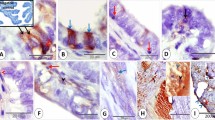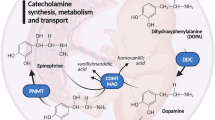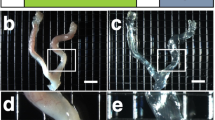Abstract
ALTHOUGH it is generally accepted that nervous tissue is absent in the human placenta and umbilical cord1, the presence or absence of nerves has long been a controversy. In a review of the literature to 1943, Spivack2 surveyed the reports of an innervation, which was variously described as adrenergic, cholinergic, myelinated, non-myelinated and a diffuse anastomosing network. Spivack, however, pointed out the difficulties of interpreting results with conventional neurological stains and described work with silver and methylene blue staining which gave no evidence of a nervous apparatus. There have been several recent reports of neuronal components in these tissues3,5. Jacobson et al.6,7 presented evidence of nerves in the placentae of human and other primate species. Using a modified methylene blue technique8,9, they suggested that this innervation was intrinsic, with groups of cell bodies within the placenta, nerve bundles in the villi and fine fibres about vessels.
This is a preview of subscription content, access via your institution
Access options
Subscribe to this journal
Receive 51 print issues and online access
$199.00 per year
only $3.90 per issue
Buy this article
- Purchase on Springer Link
- Instant access to full article PDF
Prices may be subject to local taxes which are calculated during checkout
Similar content being viewed by others
References
Bourne, G., The Human Amnion and Chorion, 276 (Lloyd-Luke, London, 1962).
Spivack, M., Anat. Rec., 85 (1943).
Coujard, R., Lapage, F., and Schramm, B., Bull. Fed. Soc. Gynec. et d'Obstet., Suppl. 4, 522 (1952).
Kernbakh, M., Akush. Iginek., 5, 15 (1959).
ten Berge, B. S., Gynecologia, 156, 49 (1963).
Jacobson, H. N., and Chapler, F. K., Nature, 214, 103 (1967).
Fox, H., and Jacobson, H. N., Acta Anat., 73, 48 (1969).
Miller, M. R., and Kasahara, M., Anat. Rec., 145, 13 (1963).
Hillarp, N.-Å., Acta Physiol. Scand., 46, Suppl. 157 (1959).
Ehinger, B., Gennser, G., Owman, Ch., Persson, H., and Sjöberg, N.-O., Acta Physiol. Scand., 72, 15 (1968).
Read, J. B., and Burnstock, G., Histochemie, 20, 197 (1970).
Nakanishi, H., McLean, J., Wood, C., and Burnstock, G., J. Reprod. Med., 2, 20 (1969).
Burnstock, G., McLean, J. R., and Wright, Mary, Brit. J. Pharmacol. (in the press).
Ehinger, B., Sporrong, B., and Stenevi, U., Histochemie, 13, 105 (1968).
Boyd, J. D., and Hamilton, W. J., The Human Placenta, 217 (Heffer, Cambridge, 1970).
Author information
Authors and Affiliations
Rights and permissions
About this article
Cite this article
WALKER, D., MCLEAN, J. Absence of Adrenergic Nerves in the Human Placenta. Nature 229, 344–345 (1971). https://doi.org/10.1038/229344a0
Received:
Issue Date:
DOI: https://doi.org/10.1038/229344a0
This article is cited by
-
In vivo noninvasive systemic myography of acute systemic vasoactivity in female pregnant mice
Nature Communications (2023)
-
Promoter methylation changes and vascular dysfunction in pre-eclamptic umbilical vein
Clinical Epigenetics (2019)
-
Colocalization of vasoactive substances in the endothelial cells of human umbilical vessels
Cell and Tissue Research (1993)
-
�ber das fetale Gef��system der reifen menschlichen Placenta
Zeitschrift f�r Zellforschung und Mikroskopische Anatomie (1973)
-
Adrenergic innervation of the umbilical vessels
Zeitschrift f�r Zellforschung und Mikroskopische Anatomie (1971)
Comments
By submitting a comment you agree to abide by our Terms and Community Guidelines. If you find something abusive or that does not comply with our terms or guidelines please flag it as inappropriate.



